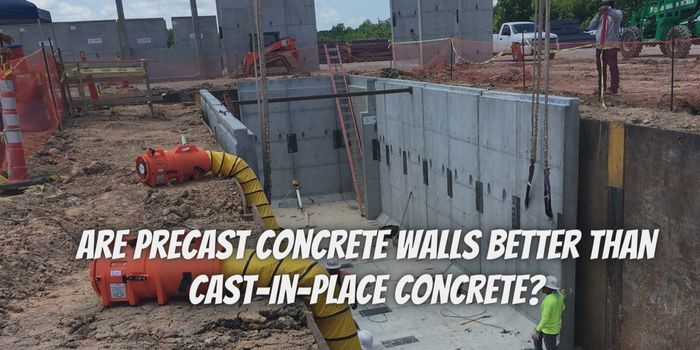You may be wondering what the differences are between precast concrete walls and cast-in-place concrete, especially if one is better than the other. Both precast concrete walls and cast-in-place concrete are excellent choices for various construction projects, but their production and installation processes are different in some ways.
Precast concrete walls are made with concrete that is mixed, poured, and cured at an offsite facility. Once fully cured, the precast concrete wall is transported to the construction site, where it is installed. On the other hand, cast-in-place concrete is mixed and poured on-site, then left to cure in place. Depending on the project size, the curing process can take several days or weeks.
Both have advantages, but the former has continued to grow in popularity over the years, with more businesses turning to precast concrete walls than cast-in-place. Below are several reasons why precast concrete walls are better than cast-in-place concrete:
1. Faster Installation Time and More Efficient
Precast walls can be faster to install since they are produced offsite in a controlled environment and then transported to the job site for installation. However, if the job site is difficult to access, or the precast pieces are large or complex, transportation and installation can be more challenging, potentially offsetting the time savings.
On top of that, precast concrete walls can be more efficient because their manufacturing process is highly standardized. They can be produced in large quantities using repeatable processes and machinery, which help to streamline the production process and reduce the time required to produce each precast concrete wall.
2. Stronger and More Durable
Since a precast concrete wall is manufactured in a controlled environment with precisely calculated combinations and curing times, it may be stronger and more durable than cast-in-place concrete. As a result, precast concrete walls can withstand extreme weather conditions and last longer than cast-in-place concrete.
However, it would help if you remembered that the materials utilized, the production method, and the care required during transit and installation all affect the precast concrete wall’s quality. Even so, it is also worth taking that cast-in-place concrete can be extremely durable if properly mixed and installed.
3. Superior Quality and Greater Customization
Precast concrete walls are of the highest quality because the mixing and curing processes are precisely regulated in a controlled environment. Unlike cast-in-place concrete, precast concrete walls are produced utilizing specialized forms. In fact, this type of concrete wall can be created in various sizes, dimensions, and configurations, including curved walls, decorative finishes, and intricate details.
Also, precast concrete walls are the best option for many different applications due to their great degree of customizability. These include light poles, sign bases, pillars, columns, parking structures, ditches, and retaining walls. Not to mention, these walls can be made and tailored to fulfill the unique requirements of each application because of their adaptability, making them a choice for many construction projects.
On the contrary, cast-in-place concrete has limited customization levels because the size and shape of the on-site formwork constrain it. Besides, precast concrete walls are also less likely to have flaws or defects like cracking or shrinkage than cast-in-place walls because of bad weather conditions, improper curing, or subpar construction.
In addition, a precast concrete wall is protected from external elements by being cured in a controlled environment with accurate control of the mixing and curing processes.
4. More Cost-effective and Less Maintenance
One of the benefits of precast concrete over cast-in-place concrete is that it can be more affordable in many construction projects. These walls are made off-site and delivered to the construction site for installation. What’s more, precast concrete walls lower the need for on-site personnel, considerably reducing the labor expenses involved in casting and curing cast-in-place concrete on-site.
Additionally, precast concrete walls are produced highly automated and standardized, making them far more productive than on-site casting. Precast concrete walls can thus be produced more quickly and at a lower cost per unit than cast-in-place concrete, making them more economical than cast-in-place concrete.
And because precast concrete walls are produced in a controlled environment with consistent quality control, they require less maintenance than cast-in-place concrete. It also results in a more reliable and long-lasting product, which can eventually reduce maintenance and repair expenses over their lifetime in a lower total cost of ownership.
Also, precast concrete walls are produced using reusable molds and formwork that can be utilized to produce numerous similar pieces at a lower cost.
Disadvantages of Precast Concrete Walls
Despite all the benefits precast concrete walls offer, there are some disadvantages too.
1. High Upfront Costs
Precast concrete walls come with a high upfront cost because of the materials and specialized labor required for installation. Currently, there’s a lot of demand for precast products, so prices could be higher than expected if you use a less unique design.
2. Longer Installation Times
Depending on how complex your design is, installation varies in length. One of the main attributes of precast concrete is its ability to be customized, so elements like making windows or doors that fit your specific measurements take longer than anticipated.
It’s still an excellent option if you’re looking for an economical way to create long-term solutions; plan and account for any delays.
Precast Concrete Walls Are Better than Cast-In-Place Concrete!
Certainly, it would be best if you considered precast concrete walls over cast-in-place concrete. For one, precast concrete walls are becoming increasingly popular for many business construction projects. This owes to their numerous benefits and advantages over cast-in-place concrete, such as faster installation time, efficiency, superior quality, strength, durability, and cost-effectiveness.
Additionally, precast concrete walls can be produced in a controlled environment with precisely regulated curing processes, resulting in a long-lasting, customizable product requiring less maintenance and repair. In addition, precast concrete walls require less on-site labor, resulting in lower labor expenses and reduced total cost of ownership over their lifetime.
As a result, more and more businesses are turning to precast concrete walls than cast-in-place concrete for their construction needs.




